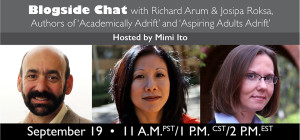Facilitators: Mike Wesch, Mimi Ito, Helen Keegan
Kick-off Live Event:
September 15, 2014 1 PM PST/3 PM CST/ 4 PM EST
Participants: Mike Wesch, Cathy Davidson, Randy Bass
Title: The End of Higher Education
Description: As shrinking budgets, skeptical publics, and rising alternatives continue to threaten the end of higher education, we host this conversation as a contemplation of what the end – or purpose – of higher education should be. We will also reflect on how individual teachers might find their own core reason for teaching a specific class, and ways to build buy-in to that reason among students.
Why We Need a Why:
As we design our courses, we have to address three questions:
What is to be taught/learned?
How should it be learned?
Why should it be learned?
We usually start by addressing the “What” question first. We have a course title or subject area and we begin populating our syllabus with the “whats” to be learned. Or, we peruse textbooks looking for the text that we think best covers the field. If we have time, we address the “How” question by considering how we can best teach the material. We sharpen our teaching technique, seek out better examples for the more difficult concepts, compile photos and videos to improve our presentations, and seek other ways to get the students engaged with the material. We may jump to incorporate the latest tools and techniques, whether it is social or interactive media or a new technique like a flipped classroom. Our syllabus, teaching materials, and educational technology in order, we rush into the semester, rarely asking, “Why?”
Starting with “Why” changes everything. When I, Mike Wesch, first started contemplating the “why” of my digital ethnography course, I realized that what I was really hoping to do was to teach my students “critical thinking.” I place “critical thinking” in quotes here because I had not yet given a great deal of thought about what I meant by the term, but I did immediately recognize that my previous “how” was completely inadequate to the task. I had spent most of my time thinking up elaborate and memorable performances (like the “shake your tailfeather” dance featured in this video) so that they would remember the concepts. Their task in my class was to simply memorize the material as performed by the authority (me) at the front of the room. Indeed, all of my teaching to that point had been in service of a very thin, unquestioned, and ultimately wrong notion of learning as the simple acquisition of knowledge.
As I contemplated the “real why” of my course further, I soon recognized that anthropology was not a bunch of content and bold faced terms that can be highlighted in a text book, but was instead a way of looking at the world. Actually, that is not quite right. It is not just a way of looking at the world. It is a way of being in the world. To underscore the difference, consider that it is one thing to be able to give a definition of cultural relativism (perhaps the most bold-faced of bold-faced terms in anthropology which means “cultural norms and values derive their meaning within a specific social context”) or even to apply it to some specific phenomenon, but it is quite another to fully incorporate that understanding and recognize yourself as a culturally and temporally bounded entity mired in cultural biases and taken-for-granted assumptions that you can only attempt to transcend.
To adopt such an understanding is often transformative and psychologically disruptive. It is not to be taken lightly, and no student will dare take on such disruption if it is not clear that there is a good reason to do so. As Neil Postman has noted, you can try to engineer the learning of what-bits (The End of Higher Education, Postman), but “to become a different person because of something you have learned — to appropriate an insight, a concept, a vision, so that your world is altered — is a different matter. For that to happen, you need a reason.” This also means asking hard questions about how new technology and techniques can support real student transformation and not simply reinforce old patterns with new tools.
This week’s make:
So what is the real “why” of your course? Why should students take it? How will they be changed by it? What is your discipline’s real “why”? Why does it matter that students take __________ courses or become _________ists? How can digital and networked technologies effectively support the real why of your course?
Write down your real why, share it in the make bank, and frame it in a blog post that explains your story and inspiration. These can be in the form of student learning objectives, but do not feel constrained by whether your objectives are measurable, realistic, or reasonable. Explore your own depths to find reasons you did not even realize were there — or reasons you have never been able to put into words. And, if you can’t quite put your reasons into words, share a story or picture that somehow conveys your otherwise inexpressible thoughts.
Make Activity #2:
What gets you up in the morning?
What’s your core reason for doing what you do?
We’ve been thinking a lot about the WHY question. Everybody has a reason WHY, but if we’re not careful we can lose sight of our WHY, and so we want to reclaim it!
Let’s celebrate the WHY!
We’d love you to share your WHY in a visual format – either short video or still image. The plan is to then compile your clips into a Connected Courses video (a crowdsourced video made by all of us – neat huh?). We’re thinking along the lines of A Vision of Students Today – one of the videos created by Mike Wesch and his students.
This video project will run alongside the opening topic for Connected Courses: Why We Need a Why. When you have found your real WHY, please do share it with us so we can include it in a crowdsourced piece. To find out more about how to contribute, click here.
Live Event: Friday, September 19, 2014 @ 11 AM PT/1 PM CST/ 2 PM EST
Blogside Chat with Richard Arum and Josipa Roksa, Authors of Academically Adrift and Aspiring Adults Adrift
Hosted by Mimi Ito
In their 2011 book, Academically Adrift, Arum and Roksa described the sobering reality that 45% of college students demonstrate very little learning during their first two years of college. They outline a shifting culture of higher education that increasingly prioritizes social and recreational campus life at the expense of academics and developing critical thinking, writing, and reasoning skills. Just released, Aspiring Adults Adrift reports on this same cohort of students as they entered the job market during the great recession. This new book paints a complex portrait of young people as they reflect on their lives and college experiences, analyzing the kinds of capacities they need to develop in order to thrive as adults. Join Mimi Ito in a conversation with the authors to discuss the implications of their research for our responsibilities as faculty and the purpose of our courses.
Presenters will take questions via Twitter hashtag #ccourses
Readings:
Your So-Called Education (NY Times)
Academically Adrift: Limited Learning on College Campuses
Aspiring Adults Adrift: Tentative Transitions of College Graduates
Live Event: Monday, September 22, 2014 @ 1:00 PM PST/3 PM CST/4 PM EST
 Describing the Why of Connected Learning
Describing the Why of Connected Learning
Participants: Mimi Ito, Vera Michalchik, and William Penuel
As educators who support connected learning experiences for our students, we often struggle to describe what we think are the deepest and most resilient learning outcomes that go beyond content mastery and skill development. Researching connected learning also involves similar challenges. We are beginning to develop research tools for documenting the features of connected learning environments, and capturing student experiences of social connection, self-expression, relevance, and interests that are at the core of connected learning. We will reflect on our ongoing research on connected learning, and offer a student survey tool that faculty can use to get at some of these broader outcomes.
Presenters will take questions via Twitter hashtag #ccourses
Inspiring videos:
Mike Wesch video from summer camp
This is Water, by David Foster Wallace (illustrated video, original speech)
Design Touchstone:
This is Water
Readings:
The question of “Why” has wide-ranging implications, not just for your course, but also for how we envision the future of higher education, especially in a world of ever-expanding digital possibility. As you read the following, try to think about how each author frames the “why” of higher education.
The Problem of Learning in Higher Education by Randy Bass
How a Class Became a Community by Cathy Davidson
Napster, Udacity, and the Academy by Clay Shirky
Who Gets to Graduate? New York Times Magazine Feature by Paul Tough
The Aims of Education by Alfred North Whitehead
Recommended:
Who are You and What are You Doing Here? by Mark Edmundson
The End of Higher Education’s Golden Age by Clay Shirky
Connected Learning: An Agenda for Research and Design by the Connected Learning Research Network
Project Euler vs. Khan Academy: the future of online learning
Papert’s The Children’s Machine (book)
Teaching as Subversive Activity by Neil Postman and Charles Weingartner (book)
The End of Education by Neil Postman (book)











